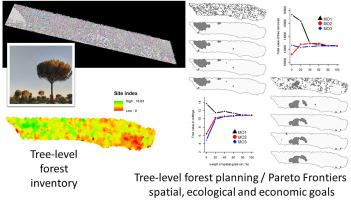Forest Policy and Economics ( IF 4.0 ) Pub Date : 2021-04-13 , DOI: 10.1016/j.forpol.2021.102475 Adrián Pascual

|
This article evaluates the conflicts between spatial, production and financial goals using tree-level decision-support built from stand dynamics equations, airborne laser scanning data and optimization based on mixed integer programming. The resulting Pareto Frontiers evaluated the role of spatial goals to create compact treatment areas along the 10-year forest plan composed of two periods. The weight of spatial goals was progressively increased to quantify the trade-offs towards (1) financial performance, (2) timber production, (3) clustering of harvesting decisions and (4) the Hart-Becking stand density index computed at tree-level using regions derived from ALS. The proposed framework was illustrated in pine forest located in Central Spain using tree-level inventory. The proposed tree selection method was feasible and provided results fast to support operational decision-making. Proved feasibility of the tree selection method optimization allowed the fast PF computation. The results showed the benefit of increasing the weight of spatial goals up to 20–40% to promote the clustering of tree harvests. The observed reduction of financial revenues from increasing priority to spatial clustering paid off, financially and operationally, considering the possible implementation of solutions, which were very dispersed when fully maximizing revenues or benefit. The assimilation of the Pareto Frontier supported with robust optimization contributes to improve forest management planning efficiency. This article turns tree-level decision making into contemporary by integrating multi-temporal decisions, using multi-objective scenarios to assess preferences, and making use of ALS technology as the vector to transform forest data into management decisions.
中文翻译:

使用机载激光扫描,生长模型和空间优化在树木级森林规划下构建帕累托边界
本文使用从机架动力学方程,机载激光扫描数据和基于混合整数编程的优化建立的树级决策支持来评估空间,生产和财务目标之间的冲突。由此产生的帕累托边界评估了空间目标的作用,以沿着由两个时期组成的10年森林计划创建紧凑的处理区。空间目标的权重逐渐增加,以量化在(1)财务绩效,(2)木材生产,(3)采伐决策的聚类和(4)在树级计算的Hart-Becking林分密度指数方面的权衡使用源自ALS的区域。使用树级清单在西班牙中部的松树林中说明了拟议的框架。所提出的树选择方法是可行的,并且可以快速提供结果以支持运营决策。经证明,树选择方法优化的可行性允许快速PF计算。结果表明,将空间目标的权重提高20%至40%以促进树木采伐集聚的好处。考虑到解决方案的可能实施,观察到的财务收入从增加优先级到空间集群的减少在财务上和运营上均获得了回报,当完全实现收入或收益最大化时,解决方案的分散性非常高。Pareto Frontier的同化以及强大的优化功能有助于提高森林管理规划效率。本文通过整合多时间决策,将树级决策转变为当代决策,











































 京公网安备 11010802027423号
京公网安备 11010802027423号